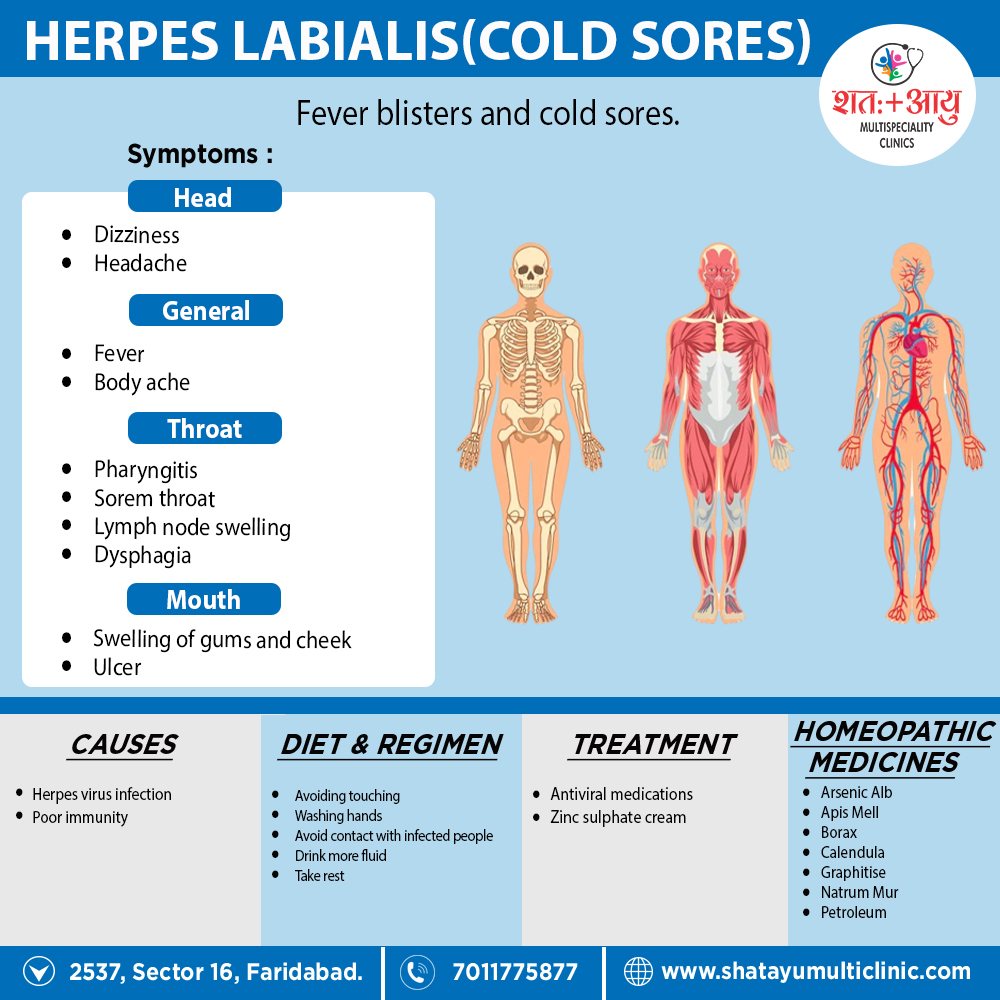Homeopathic Treatment of Herpes Labialis
Homeopathy treats the person as a whole. It means that homeopathic treatment focuses on the patient as a person, as well as his pathological condition. The homeopathic medicines selected after a full individualizing examination and case-analysis.
which includes
- The medical history of the patient,
- Physical and mental constitution,
- Family history,
- Presenting symptoms,
- Underlying pathology,
- Possible causative factors etc.
A miasmatic tendency (predisposition/susceptibility) also often taken into account for the treatment of chronic conditions.
What Homoeopathic doctors do?
A homeopathy doctor tries to treat more than just the presenting symptoms. The focus is usually on what caused the disease condition? Why ‘this patient’ is sick ‘this way’?.
The disease diagnosis is important but in homeopathy, the cause of disease not just probed to the level of bacteria and viruses. Other factors like mental, emotional and physical stress that could predispose a person to illness also looked for. No a days, even modern medicine also considers a large number of diseases as psychosomatic. The correct homeopathy remedy tries to correct this disease predisposition.
The focus is not on curing the disease but to cure the person who is sick, to restore the health. If a disease pathology not very advanced, homeopathy remedies do give a hope for cure but even in incurable cases, the quality of life can greatly improved with homeopathic medicines.
Homeopathic Medicines for Herpes Labialis (Cold sores)
The homeopathic remedies (medicines) given below indicate the therapeutic affinity but this is not a complete and definite guide to the homeopathy treatment of this condition. The symptoms listed against each homeopathic remedy may not be directly related to this disease because in homeopathy general symptoms and constitutional indications also taken into account for selecting a remedy.
Medicines:
1. Natrum Mur – Top Grade Medicine to treat Fever Blisters
- Generally, Natrum Mur is a top grade medicine for treating fever blisters.
- Furthermore, In cases needing Natrum Mur small vesicles appear around the mouth. The blisters contain watery content and appear as pearls around the mouth.
- Tiny vesicles also appear on the upper lip. Additionally, Smarting pain and burning may be there in the blisters.
- Besides this, These vesicles rupture and get covered with a scab that leaves a red spot after falling off.
- Lastly, Lips may be dry, sore and cracked. Swelling of upper lip may be present along with the above features.
2. Rhus Tox – For Blisters around the Mouth and on Chin
- Basically, Rhus Tox well indicate for fever blisters that appear around the mouth and on the chin.
- The blisters are present in clusters or group. Additionally, They fill with a watery substance.
- Sometimes yellow colored fluid is present in the vesicles. The margin of the vesicle is red.
- Besides this, Vesicles are sore to touch. A biting sensation is present in the vesicles.
- All in all, Itching may present in the vesicles with a desire to rub them with something rough.
3. Apis Mellifica – For Blisters with Stinging, Burning Pain
- Apis Mellifica wonderful medicine for fever blisters attend with stinging and burning pains.
- Vesicles are small and numerous where Apis Mellifica is needed. The vesicles may cover with yellow crusts.
- Intense itching may also feel in the vesicles.
4. Hepar Sulph – For Painful and Sensitive Fever Blisters
- Hepar Sulph is next beneficial medicine for fever blisters.
- It well indicate to treat fever blisters that are highly painful and sensitive to touch.
- A heated sensation also feel in the corners of the mouth. In cases requiring Hepar Sulph, initially, a red spot with itching appears under the lower lip where blisters form afterward.
- Blisters are most times yellowish. Blisters may also form on chin where Hepar Sulph indicate.
5. Nitric Acid – For Blisters on Lips with Stitching Pain
- Nitric Acid is useful for fever blisters on lips with stitching pain. Stitching pain is like as from splinters.
- It is most felt when touching the lips. Lips may be swollen. The lip may be cracked and sore also.
6. Arsenic Album – For Blisters with Burning Sensation
- Arsenic Album is useful for fever blisters with a prominent burning sensation.
- The blisters appear on the lips also around the mouth. Moreover, The burning sensation is most worse at night time.
- Cold air exposure also worsens the burning.
7. Graphites – For Blisters Discharging Sticky Fluid
- Graphites indicate for fever blisters discharging sticky fluid.
- The fluid is transparent, watery in addition to being sticky and glutinous.
- The affected skin also inflame and swollen. Additionally, The blisters can have violent itching and burning sometimes.
- Graphites is also indicated for fever blisters that are covered with scabs.
8. Merc Sol – For Blisters on Lips and Tongue/Gums
- Merc Sol offers help in cases of fever blisters when vesicles form on lips and also on the tongue/gums.
- On the lips, the blisters may be covered with yellow crusts.
- The blisters on tongue and gums are attended with burning pain.
- In addition to above few symptoms that may be present for using Merc Sol includes painful gums, sore throat, and fever.[3]
